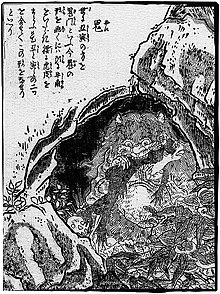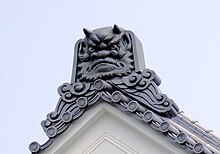Oni
An oni (鬼) is a kind of yōkai, demon, orc, ogre, or troll in Japanese folklore. They are typically portrayed as hulking figures with one or more horns growing out of their heads. Stereotypically, they are conceived of as red, blue, or white-colored, wearing loincloths of tiger pelt, and carrying iron kanabō clubs.
They are popular characters in Japanese art, literature, and theater,[1] and appear as stock villains in the well-known fairytales of Momotarō (Peach Boy), Issun-bōshi, and Kobutori Jīsan.
Description[]

Depictions of yokai oni vary widely but usually portray them as hideous, gigantic ogre-like creatures with a single horn or multiple horns emerging from their heads,[2] with sharp claws, wild hair, and fang-like tusks.[3]
They are often depicted wearing tiger-skin loincloths and carrying iron clubs called kanabō (金棒).[2] This image leads to the expression "oni with an iron club" (鬼に金棒, oni-ni-kanabō), that is, to be invincible or undefeatable.[4][5]
Their skin may be any number of colors, but red, blue, and green are particularly common.[6][7] They may sometimes also be depicted as black-skinned, or yellow-skinned.[2]
They may occasionally be depicted with a third eye on their forehead,[2][8] or extra fingers and toes.[8]
Origins[]
An old etymology for "oni" is that the word derives from on, the on'yomi reading of a character (隠) meaning "to hide or conceal", due to oni having the tendency of "hiding behind things, not wishing to appear". This explanation is found in the 10th century dictionary Wamyōshō, which reveals that the oni at the time had a different meaning, defined as "a soul/spirit of the dead".[9][10]
The character for oni, 鬼 (pinyin: guǐ; Jyutping: gwai2) in Chinese also means a dead or ancestral spirit, and not necessarily an evil specter.[9] Accordingly, Chinese (Taoist) origins for the concept of oni has been proposed.[11] Particularly powerful oni may be described as kishin or kijin (literally "oni god"; the "ki" is an alternate character reading of "oni"), a term used in Japanese Buddhism to refer to Wrathful Deities.
The oni was syncretized with Hindu-Buddhist creatures such as the man-devouring yaksha and the rakshasa, and became the oni who tormented sinners as wardens of Hell (Jigoku),[12] administering sentences passed down by Hell's magistrate, King Yama (Enma Daiō).[6] The hungry ghosts called gaki (餓鬼) has also been sometimes considered a type of oni (the Kanji for "ki" 鬼 is also read "oni").[6][10] Accordingly, a wicked soul beyond rehabilitation transforms into an oni after death. Only the very worst people turn into oni while alive, and these are the oni causing troubles among humans as presented in folk tales.[13]
Some scholars have even argued that the oni was entirely a concept of Buddhist mythology.[14]
Demon gate[]


According to Chinese Taoism and esoteric Onmyōdō, the ways of yin and yang, the northeasterly direction is termed the kimon (鬼門, "demon gate") and considered an unlucky direction through which evil spirits passed. Based on the assignment of the twelve zodiac animals to the cardinal directions, the kimon was also known as the ushitora (丑寅), or "Ox Tiger" direction. One hypothesis is that the oni's bovine horns and tiger-skin loincloth developed as a visual depiction of this term.[15][16][17]
Temples are often built facing that direction, for example, Enryaku-ji was deliberately built on Mount Hiei which was in the kimon (northeasterly) direction from Kyoto in order to guard the capital, and similarly Kan'ei-ji was built towards that direction from Edo Castle.[18][19]
However, skeptics doubt this could have been the initial design of Enryaku-ji temple, since the temple was founded in 788, six years before Kyoto even existed as a capital, and if the ruling class were so feng shui-minded, the subsequent northeasterly move of the capital from Nagaoka-kyō to Kyoto would have certainly been taboo.[20]
Japanese buildings may sometimes have L-shaped indentations at the northeast to ward against oni. For example, the walls surrounding the Kyoto Imperial Palace have notched corners in that direction.[21]
Traditional culture[]
The traditional bean-throwing custom to drive out oni is practiced during Setsubun festival in February. It involves people casting roasted soybeans indoors or out of their homes and shouting "Oni wa soto! Fuku wa uchi!" ("鬼は外!福は内!", "Oni go out! Blessings come in!").[22][23] This custom has grown from the medieval ritual of (追儺, Chinese: nuo 儺) or oni-yarai, a year-end rite to drive away oni (ghosts).[22][24]
Regionally around Tottori Prefecture during this season, a charm made of holly leaves and dried sardine heads are used as guard against oni.[24][25]
There is also a well-known game in Japan called oni gokko (鬼ごっこ), which is the same as the game of tag that children in the Western world play. The player who is "it" is instead called the "oni".[26][27]
Oni are featured in Japanese children's stories such as Momotarō (Peach Boy), Issun-bōshi, and Kobutori Jīsan.
Modern times[]
In more recent times, oni have lost some of their original wickedness[citation needed] and sometimes take on a more protective function. Men in oni costumes often lead Japanese parades to dispel any bad luck, for example.

Japanese buildings sometimes include oni-faced roof tiles called onigawara (鬼瓦), which are thought to ward away bad luck, much like gargoyles in Western tradition.[28]
Many Japanese idioms and proverbs also make reference to oni. For example, the expression "Oya ni ninu ko wa oni no ko" (親に似ぬ子は鬼の子) (Translation: "A child that does not resemble its parents is the child of an oni.") may be used by a parent to chastise a misbehaving child.[5]
Gallery[]

Oni in pilgrim's clothing. Tokugawa period. Hanging scroll, ink and color on paper. 59.2 by 22.1 centimetres (23.3 in × 8.7 in)

Depiction of an oni chanting a Buddhist prayer. The oni (ogre or demon) is dressed in the robes of a wandering Buddhist priest. He carries a gong, a striker, and a hogacho (Buddhist subscription list). By Kawanabe Kyōsai, 1864.
In popular culture[]
- The game series Touhou Project has several characters based on Oni.
- A character based on Oni appears in the Japanese Satire Anime " Tentai Senshi Sunred/Astro Fighter Sunred ", who works as an Oni for hire to dispel bad luck and also part of the "evil" organization Florsheim.
- Hyakujuu Sentai Gaoranger (and its American counterpart, Power Rangers Wild Force), Ogre Tribe Org is the main antagonist to fight the Gaorangers and Power Animals.
- The Pokémon Electabuzz is based on an oni.
- The character U+1F479 (
